Nurses' Role in Primary Health Care: Promoting Health and Prevention
VerifiedAdded on 2022/10/04
|8
|2338
|150
Report
AI Summary
This report explores the multifaceted role of nurses in primary health care, emphasizing health promotion and disease prevention strategies within the Australian healthcare context. It begins by defining primary health care and outlining the government's health strategies, with a specific focus on promoting health and preventing illnesses through screening and early intervention. The report highlights the responsibilities of nurses in health education, risk factor awareness, and providing quality care. The Ottawa Charter's health promotion strategies are then applied to a chosen primary health care nursing role, targeting the elderly population aged 65 and above. The report addresses the health concern of inadequate physical activity in this demographic, proposing the use of educational and counseling programs as a health information resource. It concludes with a critique of the health promotion resource, incorporating consumer and staff feedback to suggest modifications that would enhance the learning experience and outcomes. The report underscores the importance of nurses in policy-making, community involvement, and the implementation of effective health strategies to achieve better health outcomes.
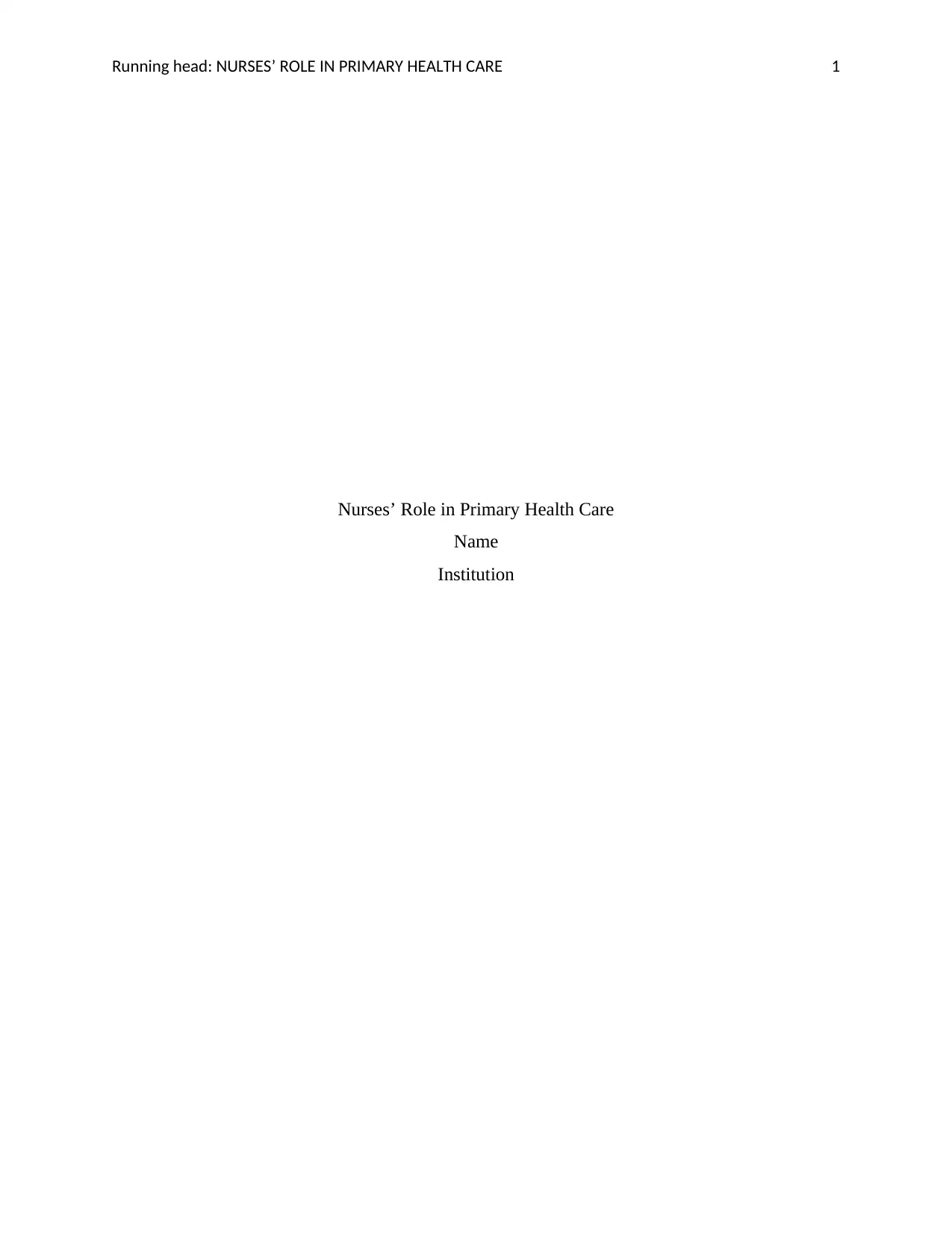
Running head: NURSES’ ROLE IN PRIMARY HEALTH CARE 1
Nurses’ Role in Primary Health Care
Name
Institution
Nurses’ Role in Primary Health Care
Name
Institution
Paraphrase This Document
Need a fresh take? Get an instant paraphrase of this document with our AI Paraphraser
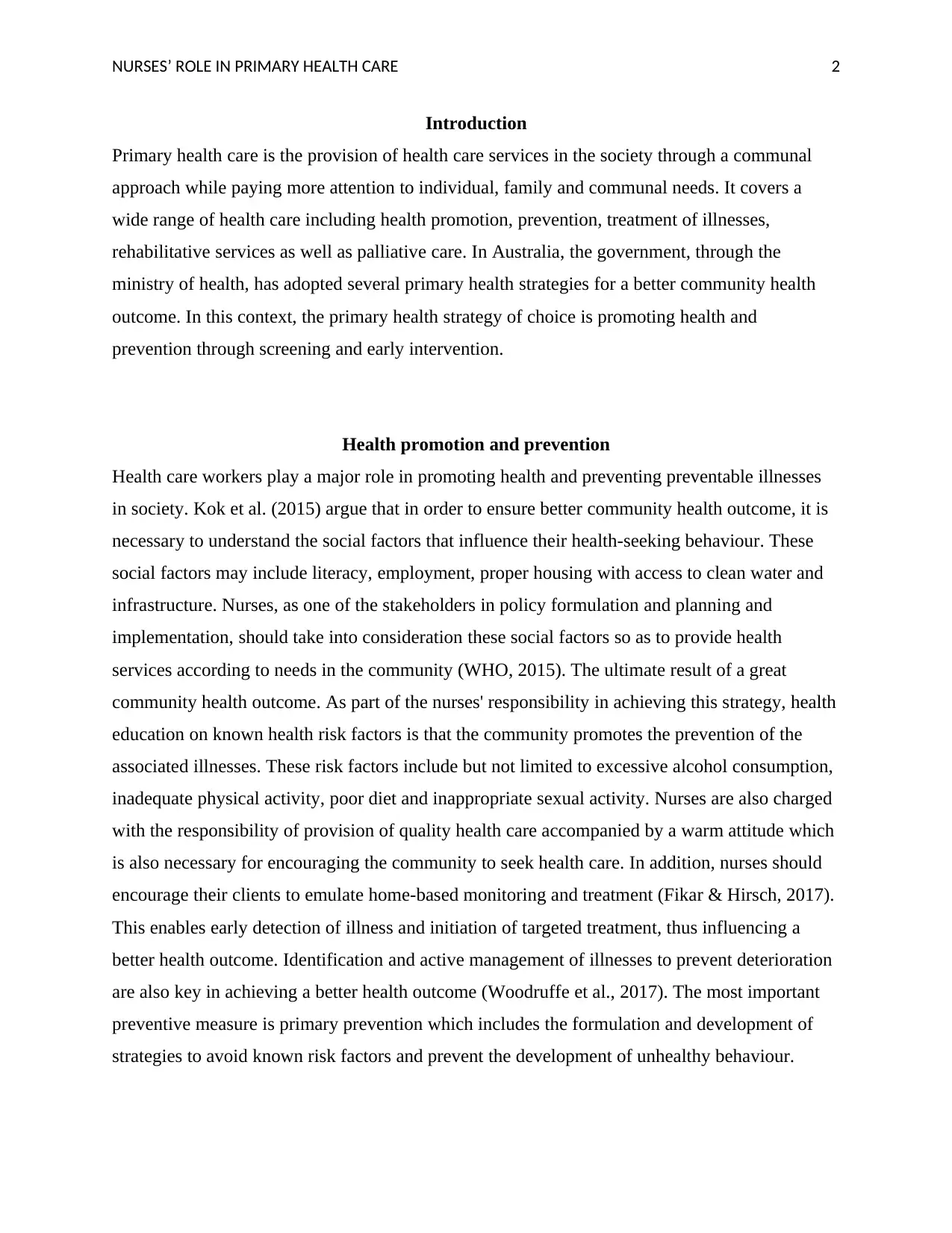
NURSES’ ROLE IN PRIMARY HEALTH CARE 2
Introduction
Primary health care is the provision of health care services in the society through a communal
approach while paying more attention to individual, family and communal needs. It covers a
wide range of health care including health promotion, prevention, treatment of illnesses,
rehabilitative services as well as palliative care. In Australia, the government, through the
ministry of health, has adopted several primary health strategies for a better community health
outcome. In this context, the primary health strategy of choice is promoting health and
prevention through screening and early intervention.
Health promotion and prevention
Health care workers play a major role in promoting health and preventing preventable illnesses
in society. Kok et al. (2015) argue that in order to ensure better community health outcome, it is
necessary to understand the social factors that influence their health-seeking behaviour. These
social factors may include literacy, employment, proper housing with access to clean water and
infrastructure. Nurses, as one of the stakeholders in policy formulation and planning and
implementation, should take into consideration these social factors so as to provide health
services according to needs in the community (WHO, 2015). The ultimate result of a great
community health outcome. As part of the nurses' responsibility in achieving this strategy, health
education on known health risk factors is that the community promotes the prevention of the
associated illnesses. These risk factors include but not limited to excessive alcohol consumption,
inadequate physical activity, poor diet and inappropriate sexual activity. Nurses are also charged
with the responsibility of provision of quality health care accompanied by a warm attitude which
is also necessary for encouraging the community to seek health care. In addition, nurses should
encourage their clients to emulate home-based monitoring and treatment (Fikar & Hirsch, 2017).
This enables early detection of illness and initiation of targeted treatment, thus influencing a
better health outcome. Identification and active management of illnesses to prevent deterioration
are also key in achieving a better health outcome (Woodruffe et al., 2017). The most important
preventive measure is primary prevention which includes the formulation and development of
strategies to avoid known risk factors and prevent the development of unhealthy behaviour.
Introduction
Primary health care is the provision of health care services in the society through a communal
approach while paying more attention to individual, family and communal needs. It covers a
wide range of health care including health promotion, prevention, treatment of illnesses,
rehabilitative services as well as palliative care. In Australia, the government, through the
ministry of health, has adopted several primary health strategies for a better community health
outcome. In this context, the primary health strategy of choice is promoting health and
prevention through screening and early intervention.
Health promotion and prevention
Health care workers play a major role in promoting health and preventing preventable illnesses
in society. Kok et al. (2015) argue that in order to ensure better community health outcome, it is
necessary to understand the social factors that influence their health-seeking behaviour. These
social factors may include literacy, employment, proper housing with access to clean water and
infrastructure. Nurses, as one of the stakeholders in policy formulation and planning and
implementation, should take into consideration these social factors so as to provide health
services according to needs in the community (WHO, 2015). The ultimate result of a great
community health outcome. As part of the nurses' responsibility in achieving this strategy, health
education on known health risk factors is that the community promotes the prevention of the
associated illnesses. These risk factors include but not limited to excessive alcohol consumption,
inadequate physical activity, poor diet and inappropriate sexual activity. Nurses are also charged
with the responsibility of provision of quality health care accompanied by a warm attitude which
is also necessary for encouraging the community to seek health care. In addition, nurses should
encourage their clients to emulate home-based monitoring and treatment (Fikar & Hirsch, 2017).
This enables early detection of illness and initiation of targeted treatment, thus influencing a
better health outcome. Identification and active management of illnesses to prevent deterioration
are also key in achieving a better health outcome (Woodruffe et al., 2017). The most important
preventive measure is primary prevention which includes the formulation and development of
strategies to avoid known risk factors and prevent the development of unhealthy behaviour.
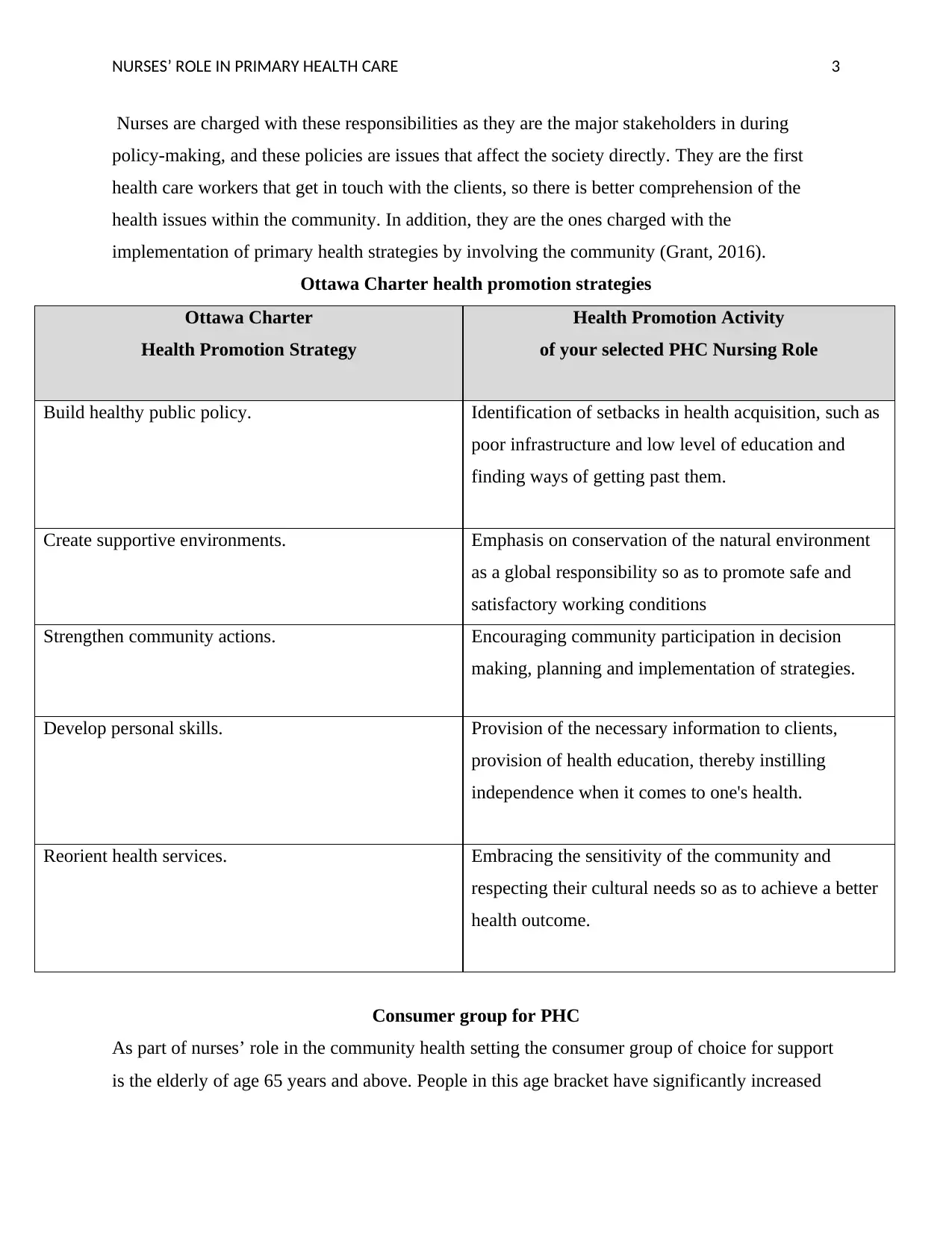
NURSES’ ROLE IN PRIMARY HEALTH CARE 3
Nurses are charged with these responsibilities as they are the major stakeholders in during
policy-making, and these policies are issues that affect the society directly. They are the first
health care workers that get in touch with the clients, so there is better comprehension of the
health issues within the community. In addition, they are the ones charged with the
implementation of primary health strategies by involving the community (Grant, 2016).
Ottawa Charter health promotion strategies
Ottawa Charter
Health Promotion Strategy
Health Promotion Activity
of your selected PHC Nursing Role
Build healthy public policy. Identification of setbacks in health acquisition, such as
poor infrastructure and low level of education and
finding ways of getting past them.
Create supportive environments. Emphasis on conservation of the natural environment
as a global responsibility so as to promote safe and
satisfactory working conditions
Strengthen community actions. Encouraging community participation in decision
making, planning and implementation of strategies.
Develop personal skills. Provision of the necessary information to clients,
provision of health education, thereby instilling
independence when it comes to one's health.
Reorient health services. Embracing the sensitivity of the community and
respecting their cultural needs so as to achieve a better
health outcome.
Consumer group for PHC
As part of nurses’ role in the community health setting the consumer group of choice for support
is the elderly of age 65 years and above. People in this age bracket have significantly increased
Nurses are charged with these responsibilities as they are the major stakeholders in during
policy-making, and these policies are issues that affect the society directly. They are the first
health care workers that get in touch with the clients, so there is better comprehension of the
health issues within the community. In addition, they are the ones charged with the
implementation of primary health strategies by involving the community (Grant, 2016).
Ottawa Charter health promotion strategies
Ottawa Charter
Health Promotion Strategy
Health Promotion Activity
of your selected PHC Nursing Role
Build healthy public policy. Identification of setbacks in health acquisition, such as
poor infrastructure and low level of education and
finding ways of getting past them.
Create supportive environments. Emphasis on conservation of the natural environment
as a global responsibility so as to promote safe and
satisfactory working conditions
Strengthen community actions. Encouraging community participation in decision
making, planning and implementation of strategies.
Develop personal skills. Provision of the necessary information to clients,
provision of health education, thereby instilling
independence when it comes to one's health.
Reorient health services. Embracing the sensitivity of the community and
respecting their cultural needs so as to achieve a better
health outcome.
Consumer group for PHC
As part of nurses’ role in the community health setting the consumer group of choice for support
is the elderly of age 65 years and above. People in this age bracket have significantly increased
⊘ This is a preview!⊘
Do you want full access?
Subscribe today to unlock all pages.

Trusted by 1+ million students worldwide
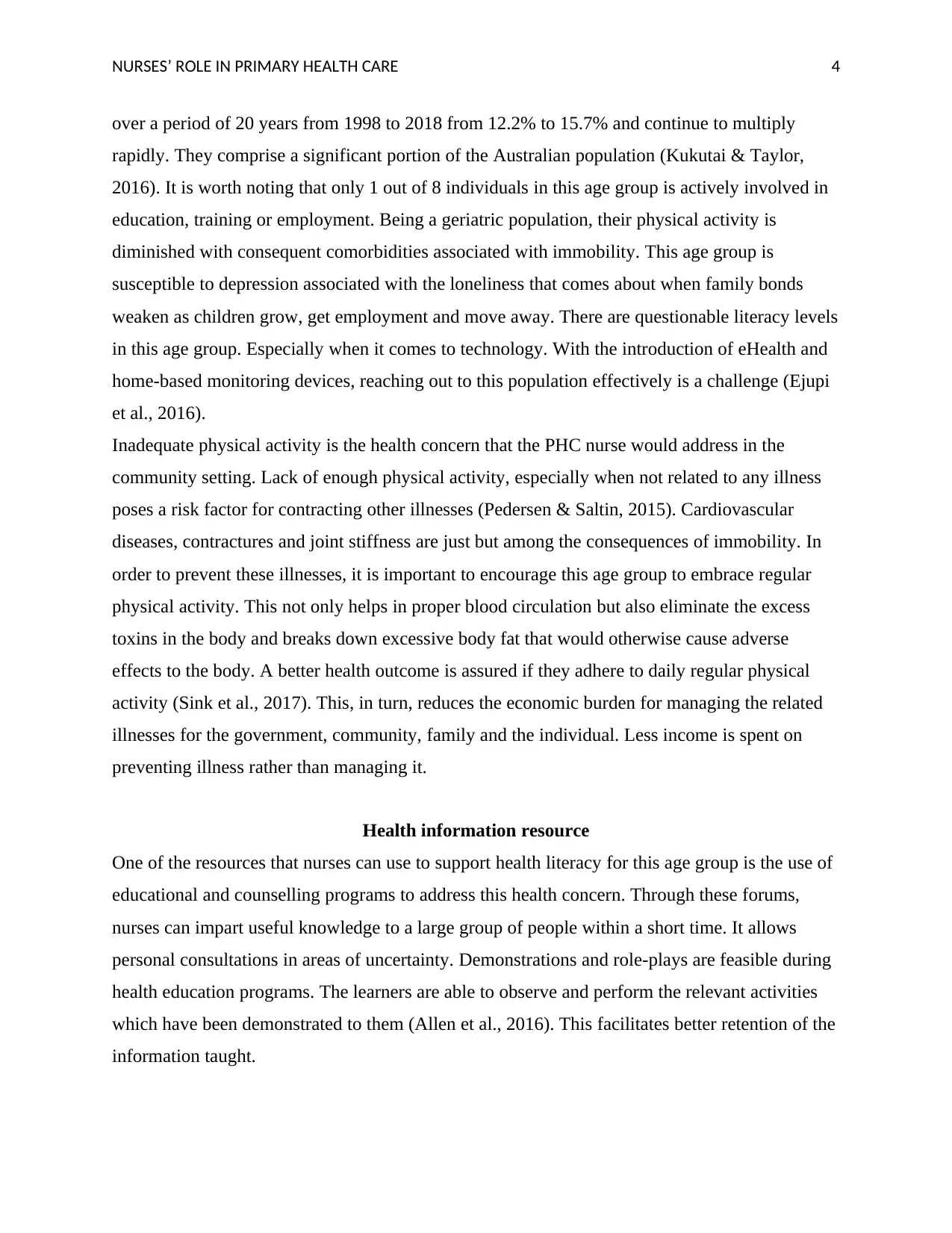
NURSES’ ROLE IN PRIMARY HEALTH CARE 4
over a period of 20 years from 1998 to 2018 from 12.2% to 15.7% and continue to multiply
rapidly. They comprise a significant portion of the Australian population (Kukutai & Taylor,
2016). It is worth noting that only 1 out of 8 individuals in this age group is actively involved in
education, training or employment. Being a geriatric population, their physical activity is
diminished with consequent comorbidities associated with immobility. This age group is
susceptible to depression associated with the loneliness that comes about when family bonds
weaken as children grow, get employment and move away. There are questionable literacy levels
in this age group. Especially when it comes to technology. With the introduction of eHealth and
home-based monitoring devices, reaching out to this population effectively is a challenge (Ejupi
et al., 2016).
Inadequate physical activity is the health concern that the PHC nurse would address in the
community setting. Lack of enough physical activity, especially when not related to any illness
poses a risk factor for contracting other illnesses (Pedersen & Saltin, 2015). Cardiovascular
diseases, contractures and joint stiffness are just but among the consequences of immobility. In
order to prevent these illnesses, it is important to encourage this age group to embrace regular
physical activity. This not only helps in proper blood circulation but also eliminate the excess
toxins in the body and breaks down excessive body fat that would otherwise cause adverse
effects to the body. A better health outcome is assured if they adhere to daily regular physical
activity (Sink et al., 2017). This, in turn, reduces the economic burden for managing the related
illnesses for the government, community, family and the individual. Less income is spent on
preventing illness rather than managing it.
Health information resource
One of the resources that nurses can use to support health literacy for this age group is the use of
educational and counselling programs to address this health concern. Through these forums,
nurses can impart useful knowledge to a large group of people within a short time. It allows
personal consultations in areas of uncertainty. Demonstrations and role-plays are feasible during
health education programs. The learners are able to observe and perform the relevant activities
which have been demonstrated to them (Allen et al., 2016). This facilitates better retention of the
information taught.
over a period of 20 years from 1998 to 2018 from 12.2% to 15.7% and continue to multiply
rapidly. They comprise a significant portion of the Australian population (Kukutai & Taylor,
2016). It is worth noting that only 1 out of 8 individuals in this age group is actively involved in
education, training or employment. Being a geriatric population, their physical activity is
diminished with consequent comorbidities associated with immobility. This age group is
susceptible to depression associated with the loneliness that comes about when family bonds
weaken as children grow, get employment and move away. There are questionable literacy levels
in this age group. Especially when it comes to technology. With the introduction of eHealth and
home-based monitoring devices, reaching out to this population effectively is a challenge (Ejupi
et al., 2016).
Inadequate physical activity is the health concern that the PHC nurse would address in the
community setting. Lack of enough physical activity, especially when not related to any illness
poses a risk factor for contracting other illnesses (Pedersen & Saltin, 2015). Cardiovascular
diseases, contractures and joint stiffness are just but among the consequences of immobility. In
order to prevent these illnesses, it is important to encourage this age group to embrace regular
physical activity. This not only helps in proper blood circulation but also eliminate the excess
toxins in the body and breaks down excessive body fat that would otherwise cause adverse
effects to the body. A better health outcome is assured if they adhere to daily regular physical
activity (Sink et al., 2017). This, in turn, reduces the economic burden for managing the related
illnesses for the government, community, family and the individual. Less income is spent on
preventing illness rather than managing it.
Health information resource
One of the resources that nurses can use to support health literacy for this age group is the use of
educational and counselling programs to address this health concern. Through these forums,
nurses can impart useful knowledge to a large group of people within a short time. It allows
personal consultations in areas of uncertainty. Demonstrations and role-plays are feasible during
health education programs. The learners are able to observe and perform the relevant activities
which have been demonstrated to them (Allen et al., 2016). This facilitates better retention of the
information taught.
Paraphrase This Document
Need a fresh take? Get an instant paraphrase of this document with our AI Paraphraser
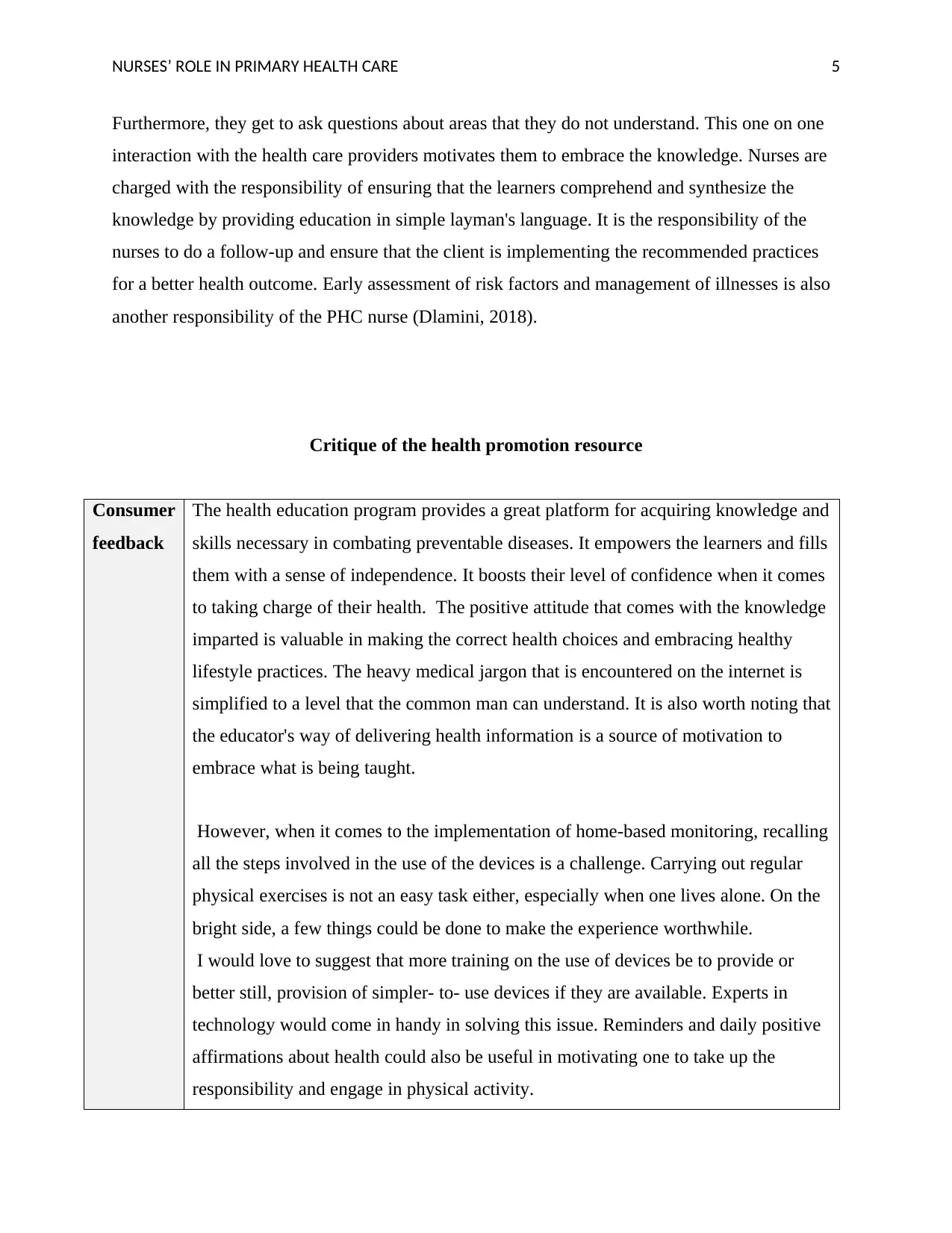
NURSES’ ROLE IN PRIMARY HEALTH CARE 5
Furthermore, they get to ask questions about areas that they do not understand. This one on one
interaction with the health care providers motivates them to embrace the knowledge. Nurses are
charged with the responsibility of ensuring that the learners comprehend and synthesize the
knowledge by providing education in simple layman's language. It is the responsibility of the
nurses to do a follow-up and ensure that the client is implementing the recommended practices
for a better health outcome. Early assessment of risk factors and management of illnesses is also
another responsibility of the PHC nurse (Dlamini, 2018).
Critique of the health promotion resource
Consumer
feedback
The health education program provides a great platform for acquiring knowledge and
skills necessary in combating preventable diseases. It empowers the learners and fills
them with a sense of independence. It boosts their level of confidence when it comes
to taking charge of their health. The positive attitude that comes with the knowledge
imparted is valuable in making the correct health choices and embracing healthy
lifestyle practices. The heavy medical jargon that is encountered on the internet is
simplified to a level that the common man can understand. It is also worth noting that
the educator's way of delivering health information is a source of motivation to
embrace what is being taught.
However, when it comes to the implementation of home-based monitoring, recalling
all the steps involved in the use of the devices is a challenge. Carrying out regular
physical exercises is not an easy task either, especially when one lives alone. On the
bright side, a few things could be done to make the experience worthwhile.
I would love to suggest that more training on the use of devices be to provide or
better still, provision of simpler- to- use devices if they are available. Experts in
technology would come in handy in solving this issue. Reminders and daily positive
affirmations about health could also be useful in motivating one to take up the
responsibility and engage in physical activity.
Furthermore, they get to ask questions about areas that they do not understand. This one on one
interaction with the health care providers motivates them to embrace the knowledge. Nurses are
charged with the responsibility of ensuring that the learners comprehend and synthesize the
knowledge by providing education in simple layman's language. It is the responsibility of the
nurses to do a follow-up and ensure that the client is implementing the recommended practices
for a better health outcome. Early assessment of risk factors and management of illnesses is also
another responsibility of the PHC nurse (Dlamini, 2018).
Critique of the health promotion resource
Consumer
feedback
The health education program provides a great platform for acquiring knowledge and
skills necessary in combating preventable diseases. It empowers the learners and fills
them with a sense of independence. It boosts their level of confidence when it comes
to taking charge of their health. The positive attitude that comes with the knowledge
imparted is valuable in making the correct health choices and embracing healthy
lifestyle practices. The heavy medical jargon that is encountered on the internet is
simplified to a level that the common man can understand. It is also worth noting that
the educator's way of delivering health information is a source of motivation to
embrace what is being taught.
However, when it comes to the implementation of home-based monitoring, recalling
all the steps involved in the use of the devices is a challenge. Carrying out regular
physical exercises is not an easy task either, especially when one lives alone. On the
bright side, a few things could be done to make the experience worthwhile.
I would love to suggest that more training on the use of devices be to provide or
better still, provision of simpler- to- use devices if they are available. Experts in
technology would come in handy in solving this issue. Reminders and daily positive
affirmations about health could also be useful in motivating one to take up the
responsibility and engage in physical activity.
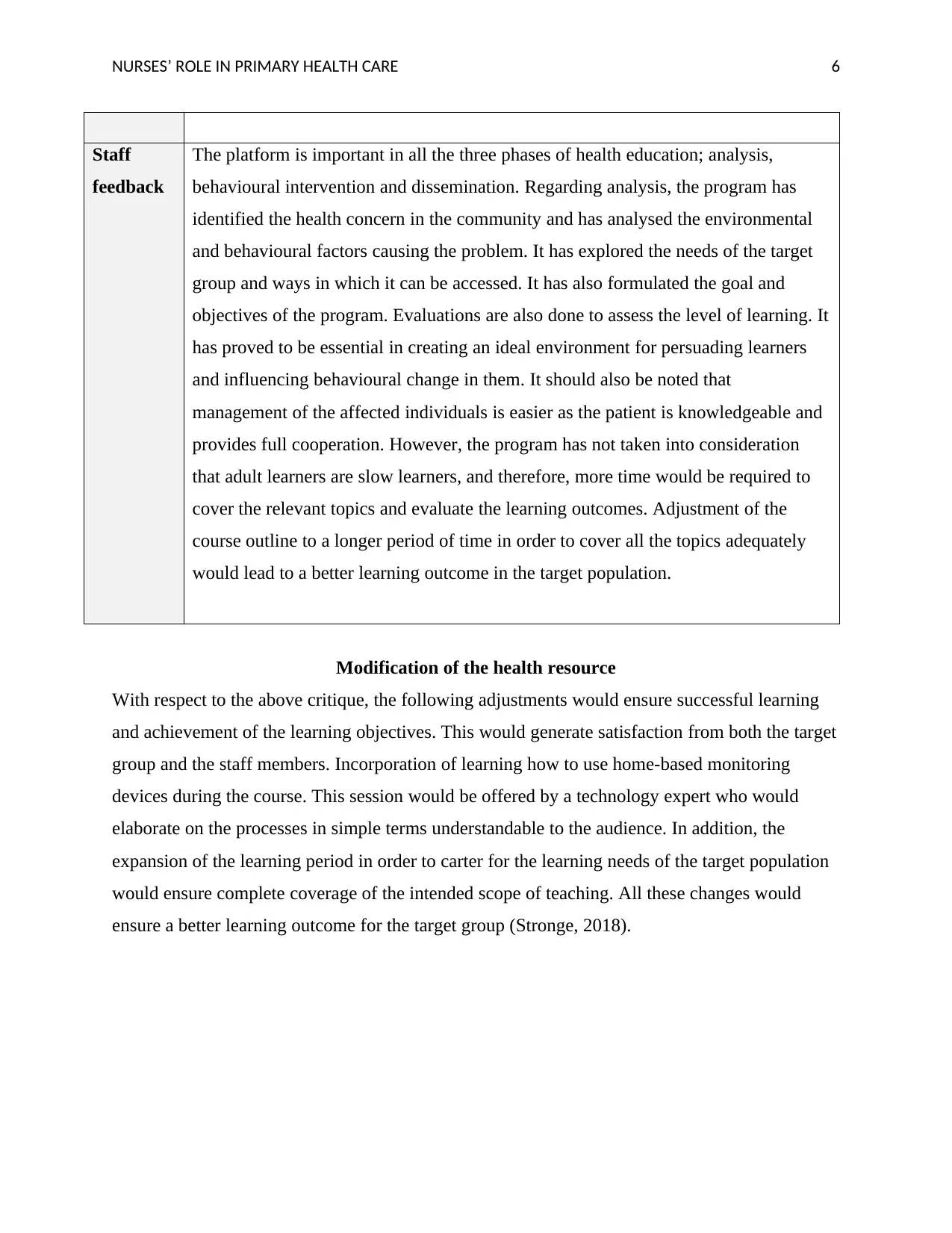
NURSES’ ROLE IN PRIMARY HEALTH CARE 6
Staff
feedback
The platform is important in all the three phases of health education; analysis,
behavioural intervention and dissemination. Regarding analysis, the program has
identified the health concern in the community and has analysed the environmental
and behavioural factors causing the problem. It has explored the needs of the target
group and ways in which it can be accessed. It has also formulated the goal and
objectives of the program. Evaluations are also done to assess the level of learning. It
has proved to be essential in creating an ideal environment for persuading learners
and influencing behavioural change in them. It should also be noted that
management of the affected individuals is easier as the patient is knowledgeable and
provides full cooperation. However, the program has not taken into consideration
that adult learners are slow learners, and therefore, more time would be required to
cover the relevant topics and evaluate the learning outcomes. Adjustment of the
course outline to a longer period of time in order to cover all the topics adequately
would lead to a better learning outcome in the target population.
Modification of the health resource
With respect to the above critique, the following adjustments would ensure successful learning
and achievement of the learning objectives. This would generate satisfaction from both the target
group and the staff members. Incorporation of learning how to use home-based monitoring
devices during the course. This session would be offered by a technology expert who would
elaborate on the processes in simple terms understandable to the audience. In addition, the
expansion of the learning period in order to carter for the learning needs of the target population
would ensure complete coverage of the intended scope of teaching. All these changes would
ensure a better learning outcome for the target group (Stronge, 2018).
Staff
feedback
The platform is important in all the three phases of health education; analysis,
behavioural intervention and dissemination. Regarding analysis, the program has
identified the health concern in the community and has analysed the environmental
and behavioural factors causing the problem. It has explored the needs of the target
group and ways in which it can be accessed. It has also formulated the goal and
objectives of the program. Evaluations are also done to assess the level of learning. It
has proved to be essential in creating an ideal environment for persuading learners
and influencing behavioural change in them. It should also be noted that
management of the affected individuals is easier as the patient is knowledgeable and
provides full cooperation. However, the program has not taken into consideration
that adult learners are slow learners, and therefore, more time would be required to
cover the relevant topics and evaluate the learning outcomes. Adjustment of the
course outline to a longer period of time in order to cover all the topics adequately
would lead to a better learning outcome in the target population.
Modification of the health resource
With respect to the above critique, the following adjustments would ensure successful learning
and achievement of the learning objectives. This would generate satisfaction from both the target
group and the staff members. Incorporation of learning how to use home-based monitoring
devices during the course. This session would be offered by a technology expert who would
elaborate on the processes in simple terms understandable to the audience. In addition, the
expansion of the learning period in order to carter for the learning needs of the target population
would ensure complete coverage of the intended scope of teaching. All these changes would
ensure a better learning outcome for the target group (Stronge, 2018).
⊘ This is a preview!⊘
Do you want full access?
Subscribe today to unlock all pages.

Trusted by 1+ million students worldwide
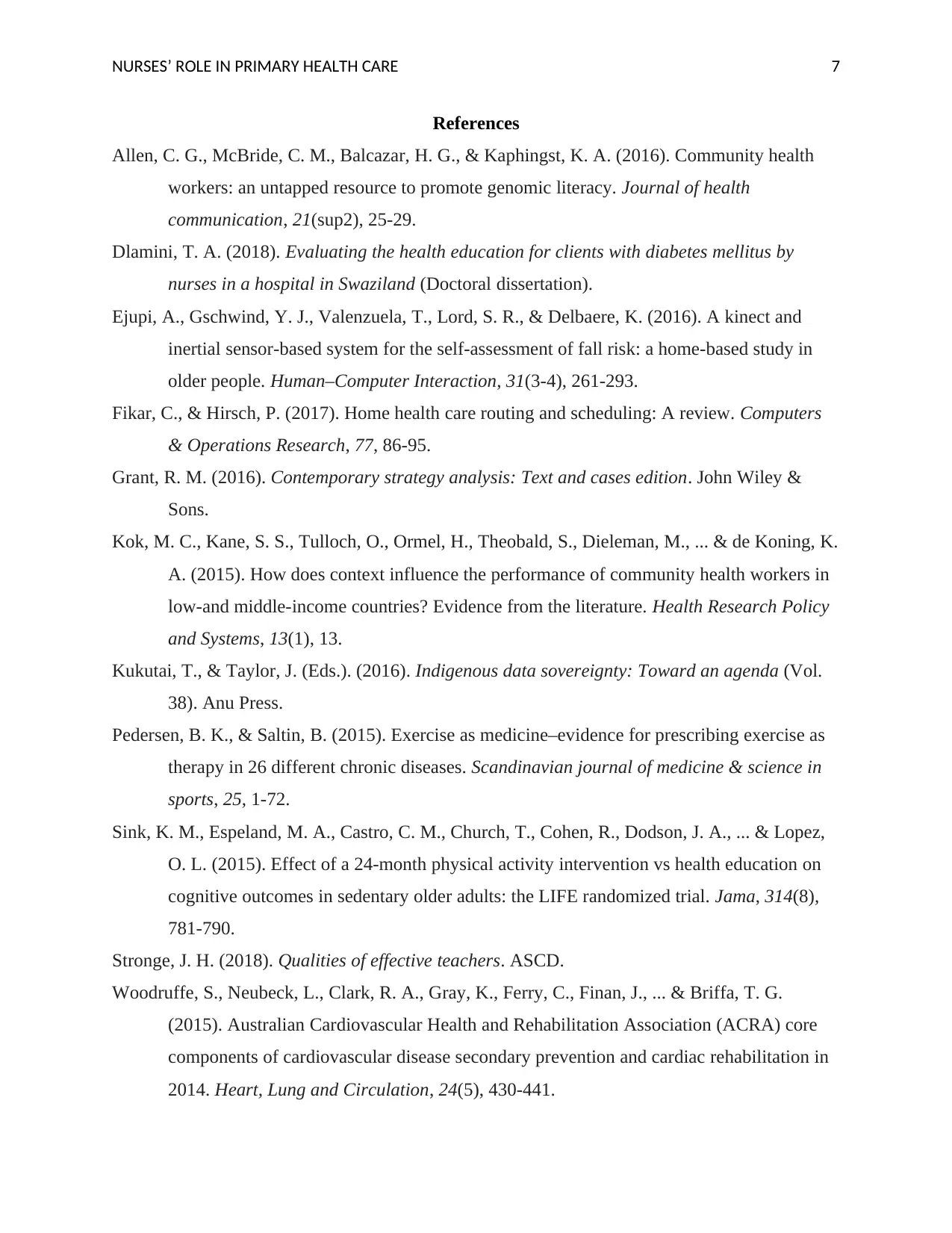
NURSES’ ROLE IN PRIMARY HEALTH CARE 7
References
Allen, C. G., McBride, C. M., Balcazar, H. G., & Kaphingst, K. A. (2016). Community health
workers: an untapped resource to promote genomic literacy. Journal of health
communication, 21(sup2), 25-29.
Dlamini, T. A. (2018). Evaluating the health education for clients with diabetes mellitus by
nurses in a hospital in Swaziland (Doctoral dissertation).
Ejupi, A., Gschwind, Y. J., Valenzuela, T., Lord, S. R., & Delbaere, K. (2016). A kinect and
inertial sensor-based system for the self-assessment of fall risk: a home-based study in
older people. Human–Computer Interaction, 31(3-4), 261-293.
Fikar, C., & Hirsch, P. (2017). Home health care routing and scheduling: A review. Computers
& Operations Research, 77, 86-95.
Grant, R. M. (2016). Contemporary strategy analysis: Text and cases edition. John Wiley &
Sons.
Kok, M. C., Kane, S. S., Tulloch, O., Ormel, H., Theobald, S., Dieleman, M., ... & de Koning, K.
A. (2015). How does context influence the performance of community health workers in
low-and middle-income countries? Evidence from the literature. Health Research Policy
and Systems, 13(1), 13.
Kukutai, T., & Taylor, J. (Eds.). (2016). Indigenous data sovereignty: Toward an agenda (Vol.
38). Anu Press.
Pedersen, B. K., & Saltin, B. (2015). Exercise as medicine–evidence for prescribing exercise as
therapy in 26 different chronic diseases. Scandinavian journal of medicine & science in
sports, 25, 1-72.
Sink, K. M., Espeland, M. A., Castro, C. M., Church, T., Cohen, R., Dodson, J. A., ... & Lopez,
O. L. (2015). Effect of a 24-month physical activity intervention vs health education on
cognitive outcomes in sedentary older adults: the LIFE randomized trial. Jama, 314(8),
781-790.
Stronge, J. H. (2018). Qualities of effective teachers. ASCD.
Woodruffe, S., Neubeck, L., Clark, R. A., Gray, K., Ferry, C., Finan, J., ... & Briffa, T. G.
(2015). Australian Cardiovascular Health and Rehabilitation Association (ACRA) core
components of cardiovascular disease secondary prevention and cardiac rehabilitation in
2014. Heart, Lung and Circulation, 24(5), 430-441.
References
Allen, C. G., McBride, C. M., Balcazar, H. G., & Kaphingst, K. A. (2016). Community health
workers: an untapped resource to promote genomic literacy. Journal of health
communication, 21(sup2), 25-29.
Dlamini, T. A. (2018). Evaluating the health education for clients with diabetes mellitus by
nurses in a hospital in Swaziland (Doctoral dissertation).
Ejupi, A., Gschwind, Y. J., Valenzuela, T., Lord, S. R., & Delbaere, K. (2016). A kinect and
inertial sensor-based system for the self-assessment of fall risk: a home-based study in
older people. Human–Computer Interaction, 31(3-4), 261-293.
Fikar, C., & Hirsch, P. (2017). Home health care routing and scheduling: A review. Computers
& Operations Research, 77, 86-95.
Grant, R. M. (2016). Contemporary strategy analysis: Text and cases edition. John Wiley &
Sons.
Kok, M. C., Kane, S. S., Tulloch, O., Ormel, H., Theobald, S., Dieleman, M., ... & de Koning, K.
A. (2015). How does context influence the performance of community health workers in
low-and middle-income countries? Evidence from the literature. Health Research Policy
and Systems, 13(1), 13.
Kukutai, T., & Taylor, J. (Eds.). (2016). Indigenous data sovereignty: Toward an agenda (Vol.
38). Anu Press.
Pedersen, B. K., & Saltin, B. (2015). Exercise as medicine–evidence for prescribing exercise as
therapy in 26 different chronic diseases. Scandinavian journal of medicine & science in
sports, 25, 1-72.
Sink, K. M., Espeland, M. A., Castro, C. M., Church, T., Cohen, R., Dodson, J. A., ... & Lopez,
O. L. (2015). Effect of a 24-month physical activity intervention vs health education on
cognitive outcomes in sedentary older adults: the LIFE randomized trial. Jama, 314(8),
781-790.
Stronge, J. H. (2018). Qualities of effective teachers. ASCD.
Woodruffe, S., Neubeck, L., Clark, R. A., Gray, K., Ferry, C., Finan, J., ... & Briffa, T. G.
(2015). Australian Cardiovascular Health and Rehabilitation Association (ACRA) core
components of cardiovascular disease secondary prevention and cardiac rehabilitation in
2014. Heart, Lung and Circulation, 24(5), 430-441.
Paraphrase This Document
Need a fresh take? Get an instant paraphrase of this document with our AI Paraphraser
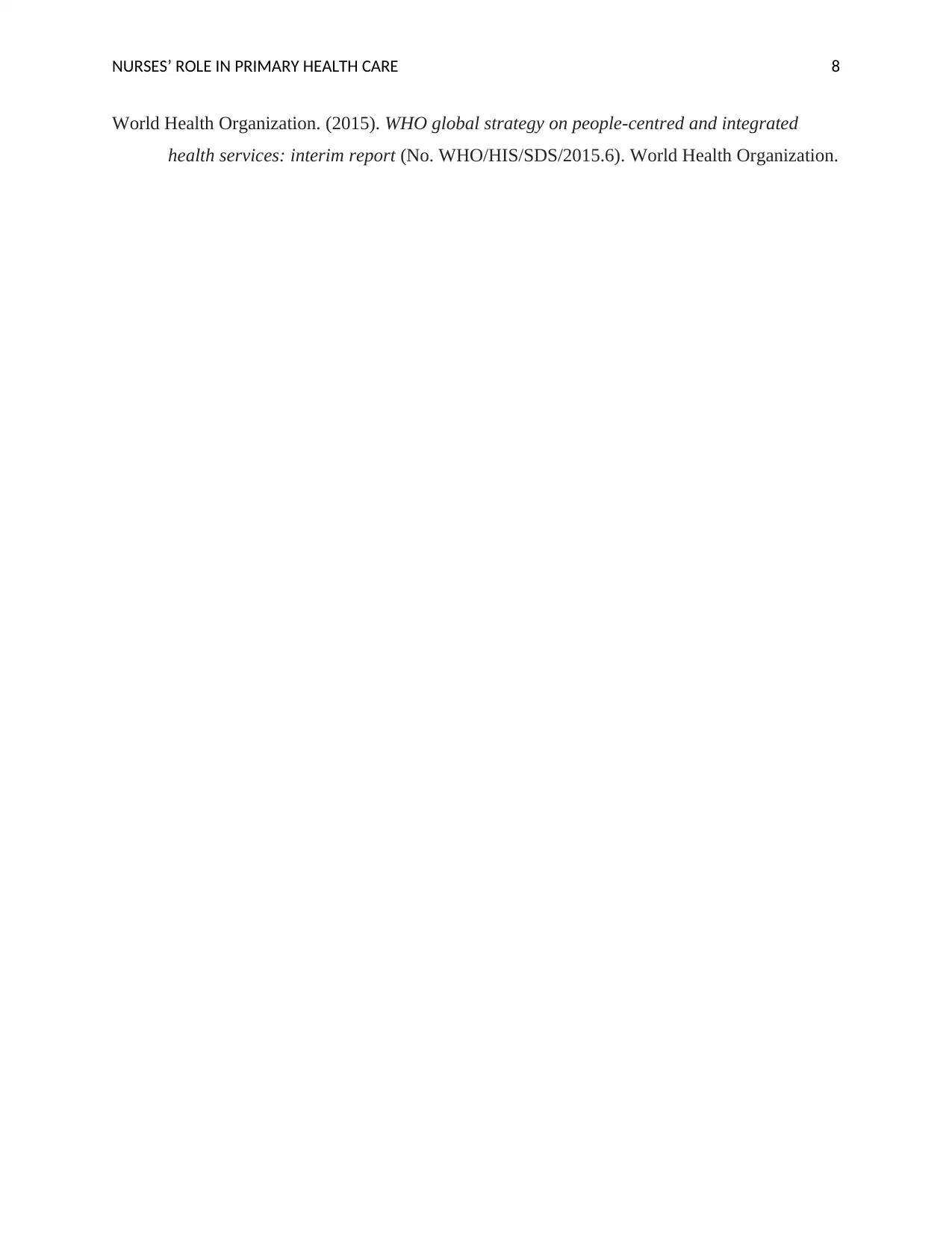
NURSES’ ROLE IN PRIMARY HEALTH CARE 8
World Health Organization. (2015). WHO global strategy on people-centred and integrated
health services: interim report (No. WHO/HIS/SDS/2015.6). World Health Organization.
World Health Organization. (2015). WHO global strategy on people-centred and integrated
health services: interim report (No. WHO/HIS/SDS/2015.6). World Health Organization.
1 out of 8
Related Documents
Your All-in-One AI-Powered Toolkit for Academic Success.
+13062052269
info@desklib.com
Available 24*7 on WhatsApp / Email
![[object Object]](/_next/static/media/star-bottom.7253800d.svg)
Unlock your academic potential
Copyright © 2020–2025 A2Z Services. All Rights Reserved. Developed and managed by ZUCOL.




